key RENAULT TWINGO RS 2009 2.G Electrical Equipment - Multimedia Connection Workshop Manual
[x] Cancel search | Manufacturer: RENAULT, Model Year: 2009, Model line: TWINGO RS, Model: RENAULT TWINGO RS 2009 2.GPages: 48, PDF Size: 0.29 MB
Page 2 of 48
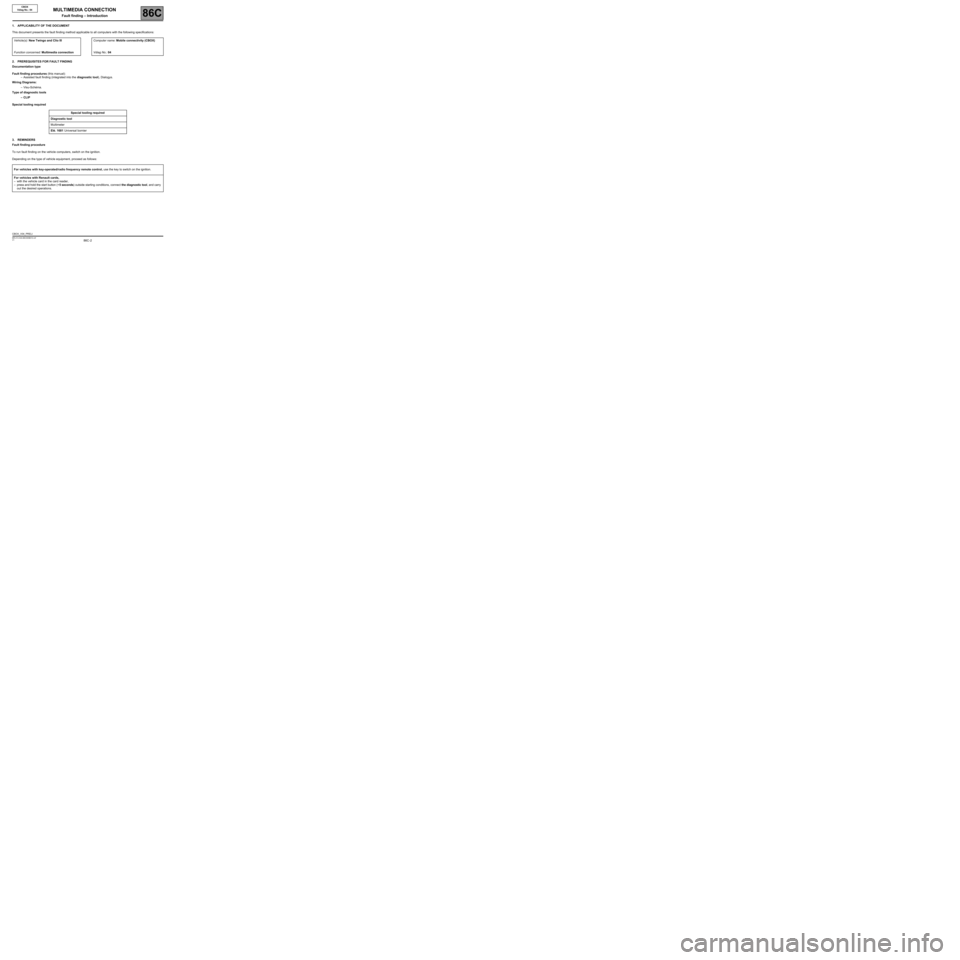
86C -2V1 MR-413-X44-86C000$010.mif
86C
CBOX
Vdiag No.: 04
1. APPLICABILITY OF THE DOCUMENT
This document presents the fault finding method applicable to all computers with the following specifications:
2. PREREQUISITES FOR FAULT FINDING
Documentation type
Fault finding procedures (this manual):
–Assisted fault finding (integrated into the diagnostic tool), Dialogys.
Wiring Diagrams:
–Visu-Schéma.
Type of diagnostic tools
–CLIP
Special tooling required
3. REMINDERS
Fault finding procedure
To run fault finding on the vehicle computers, switch on the ignition.
Depending on the type of vehicle equipment, proceed as follows:Vehicle(s): New Twingo and Clio IIIComputer name: Mobile connectivity (CBOX)
Function concerned: Multimedia connectionVdiag No.: 04
Special tooling required
Diagnostic tool
Multimeter
Elé. 1681 Universal bornier
For vehicles with key-operated/radio frequency remote control, use the key to switch on the ignition.
For vehicles with Renault cards,
–with the vehicle card in the card reader,
–press and hold the start button (+5 seconds) outside starting conditions, connect the diagnostic tool, and carry
out the desired operations.
CBOX_V04_PRELI
MULTIMEDIA CONNECTION
Fault finding – Introduction
Page 3 of 48
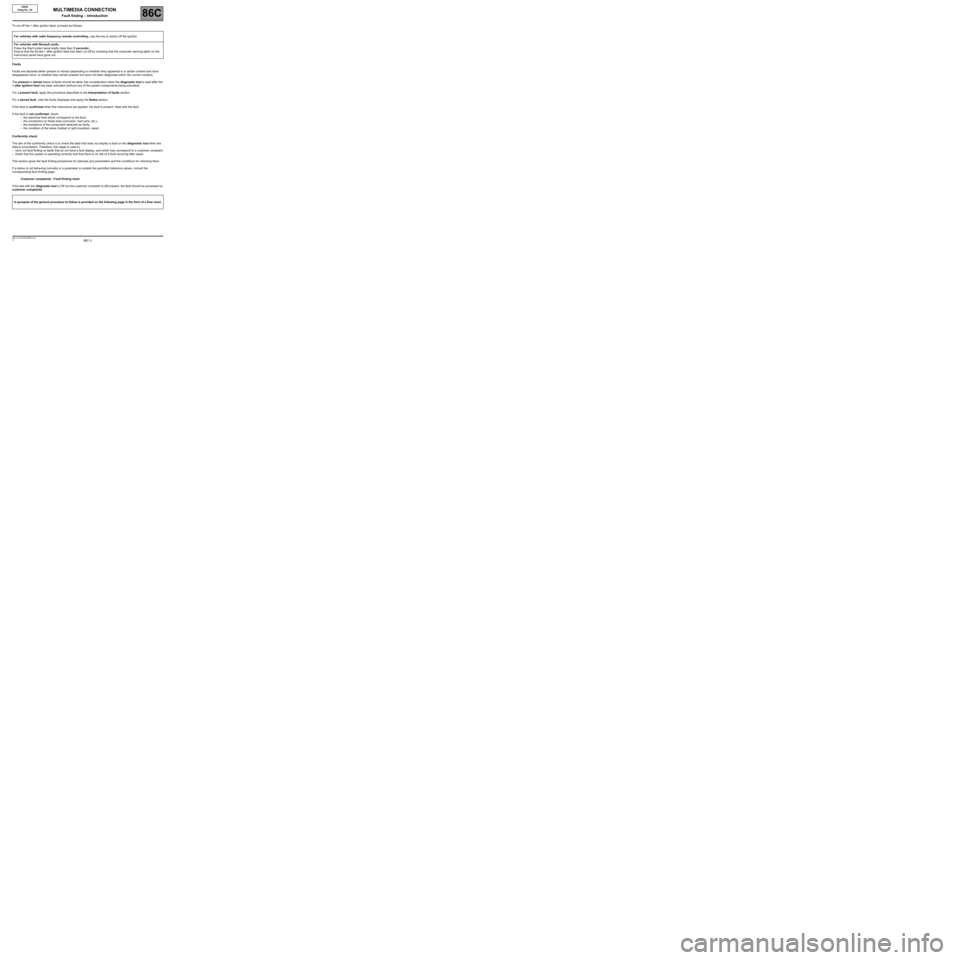
86C -3V1 MR-413-X44-86C000$010.mif
MULTIMEDIA CONNECTION
Fault finding – Introduction86C
CBOX
Vdiag No.: 04
To cut off the + after ignition feed, proceed as follows:
Faults
Faults are declared either present or stored (depending on whether they appeared in a certain context and have
disappeared since, or whether they remain present but have not been diagnosed within the current context).
The present or stored status of faults should be taken into consideration when the diagnostic tool is used after the
+ after ignition feed has been activated (without any of the system components being activated).
For a present fault, apply the procedure described in the Interpretation of faults section.
For a stored fault, note the faults displayed and apply the Notes section.
If the fault is confirmed when the instructions are applied, the fault is present. Deal with the fault.
If the fault is not confirmed, check:
–the electrical lines which correspond to the fault,
–the connectors on these lines (corrosion, bent pins, etc.),
–the resistance of the component detected as faulty,
–the condition of the wires (melted or split insulation, wear).
Conformity check
The aim of the conformity check is to check the data that does not display a fault on the diagnostic tool when the
data is inconsistent. Therefore, this stage is used to:
–carry out fault finding on faults that do not have a fault display, and which may correspond to a customer complaint.
–check that the system is operating correctly and that there is no risk of a fault recurring after repair.
This section gives the fault finding procedures for statuses and parameters and the conditions for checking them.
If a status is not behaving normally or a parameter is outside the permitted tolerance values, consult the
corresponding fault finding page.
Customer complaints - Fault finding chart
If the test with the diagnostic tool is OK but the customer complaint is still present, the fault should be processed by
customer complaints. For vehicles with radio frequency remote control/key, use the key to switch off the ignition.
For vehicles with Renault cards,
Press the Start button twice briefly (less than 3 seconds),
Ensure that the forced + after ignition feed has been cut off by checking that the computer warning lights on the
instrument panel have gone out.
A synopsis of the general procedure to follow is provided on the following page in the form of a flow chart.
Page 18 of 48
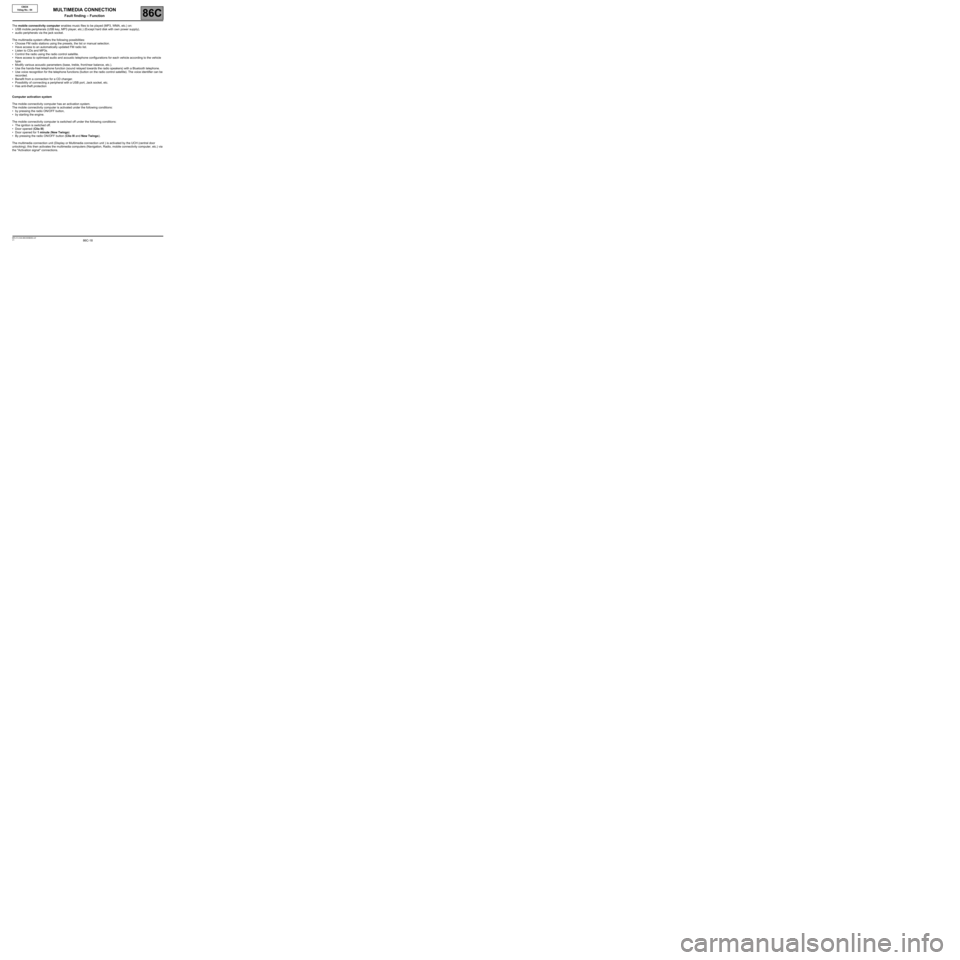
86C-18V1 MR-413-X44-86C000$050.mif
86C
CBOX
Vdiag No.: 04
The mobile connectivity computer enables music files to be played (MP3, WMA, etc.) on:
•USB mobile peripherals (USB key, MP3 player, etc.) (Except hard disk with own power supply),
•audio peripherals via the jack socket.
The multimedia system offers the following possibilities:
•Choose FM radio stations using the presets, the list or manual selection.
•Have access to an automatically updated FM radio list.
•Listen to CDs and MP3s.
•Control the radio using the radio control satellite.
•Have access to optimised audio and acoustic telephone configurations for each vehicle according to the vehicle
type.
•Modify various acoustic parameters (base, treble, front/rear balance, etc.).
•Use the hands-free telephone function (sound relayed towards the radio speakers) with a Bluetooth telephone.
•Use voice recognition for the telephone functions (button on the radio control satellite). The voice identifier can be
recorded.
•Benefit from a connection for a CD changer.
•Possibility of connecting a peripheral with a USB port, Jack socket, etc.
•Has anti-theft protection
Computer activation system
The mobile connectivity computer has an activation system.
The mobile connectivity computer is activated under the following conditions:
•by pressing the radio ON/OFF button,
•by starting the engine.
The mobile connectivity computer is switched off under the following conditions:
•The ignition is switched off.
•Door opened (Clio III)
•Door opened for 1 minute (New Twingo)
•By pressing the radio ON/OFF button (Clio III and New Twingo).
The multimedia connection unit (Display or Multimedia connection unit ) is activated by the UCH (central door
unlocking); this then activates the multimedia computers (Navigation, Radio, mobile connectivity computer, etc.) via
the "Activation signal" connections.
MULTIMEDIA CONNECTION
Fault finding – Function
Page 25 of 48
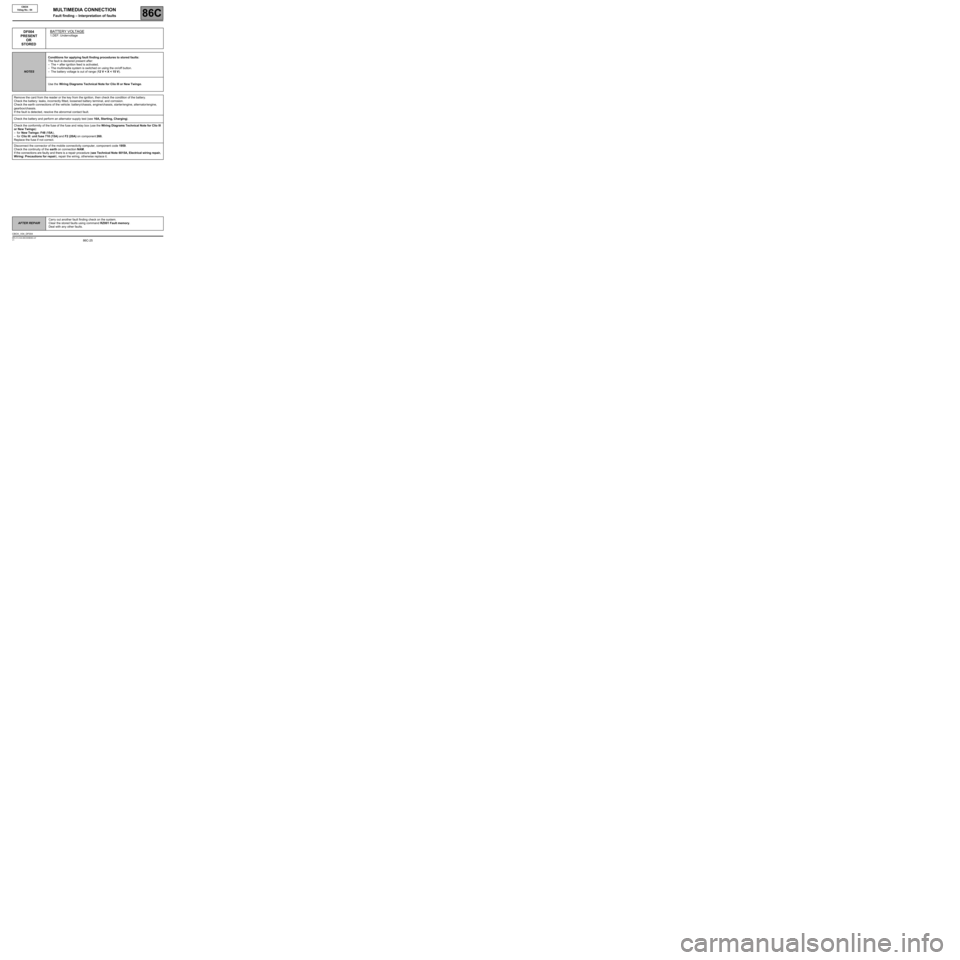
86C-25
AFTER REPAIRCarry out another fault finding check on the system.
Clear the stored faults using command RZ001 Fault memory.
Deal with any other faults.
V1 MR-413-X44-86C000$090.mif
MULTIMEDIA CONNECTION
Fault finding – Interpretation of faults86C
CBOX
Vdiag No.: 04
DF004
PRESENT
OR
STOREDBATTERY VOLTAGE
1.DEF: Undervoltage
NOTESConditions for applying fault finding procedures to stored faults:
The fault is declared present after:
–The + after ignition feed is activated,
–The multimedia system is switched on using the on/off button.
–The battery voltage is out of range (12 V < X < 15 V).
Use the Wiring Diagrams Technical Note for Clio III or New Twingo.
Remove the card from the reader or the key from the ignition, then check the condition of the battery.
Check the battery: leaks, incorrectly fitted, loosened battery terminal, and corrosion.
Check the earth connections of the vehicle: battery/chassis, engine/chassis, starter/engine, alternator/engine,
gearbox/chassis.
If the fault is detected, resolve the abnormal contact fault.
Check the battery and perform an alternator supply test (see 16A, Starting, Charging).
Check the conformity of the fuse of the fuse and relay box (use the Wiring Diagrams Technical Note for Clio III
or New Twingo):
–for New Twingo: F48 (15A),
–for Clio III: unit fuse 710 (15A) and F2 (20A) on component 260.
Replace the fuse if not correct.
Disconnect the connector of the mobile connectivity computer, component code 1959.
Check the continuity of the earth on connection NAM.
If the connections are faulty and there is a repair procedure (see Technical Note 6015A, Electrical wiring repair,
Wiring: Precautions for repair), repair the wiring, otherwise replace it.
CBOX_V04_DF004
Page 42 of 48
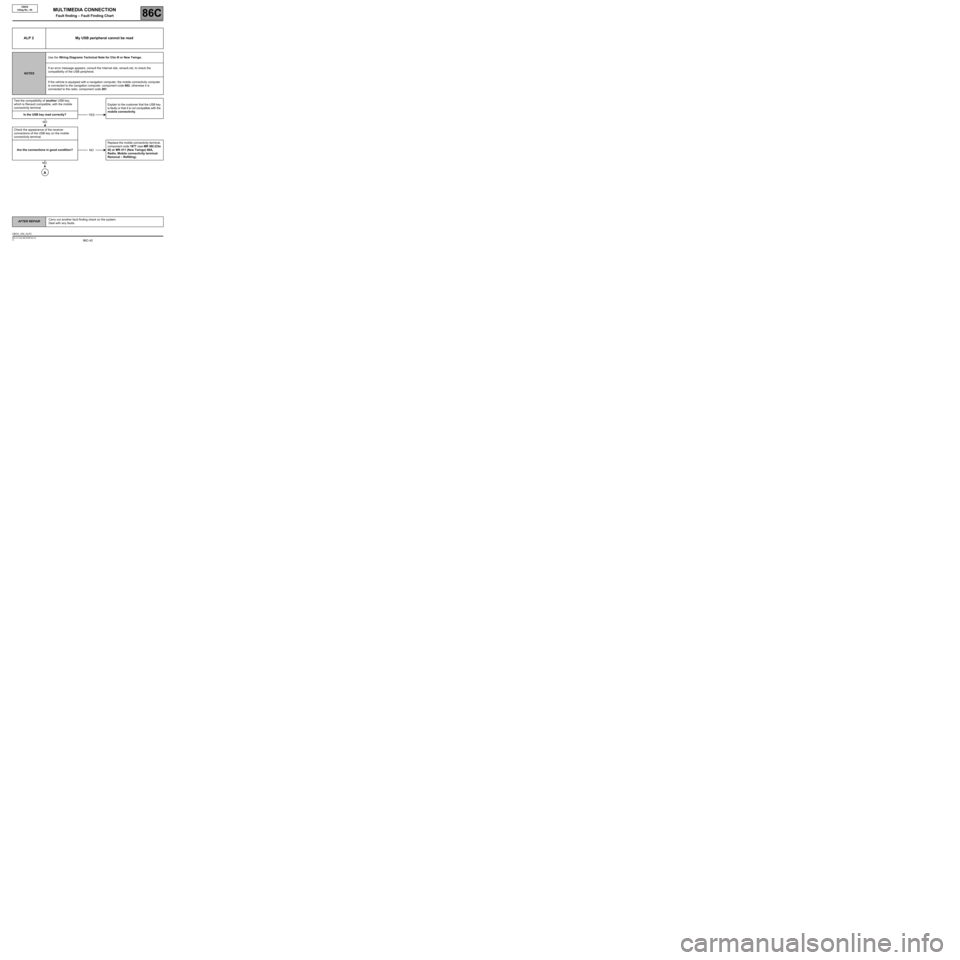
86C-42
AFTER REPAIRCarry out another fault finding check on the system.
Deal with any faults.
V1 MR-413-X44-86C000$150.mif
MULTIMEDIA CONNECTION
Fault finding – Fault Finding Chart86C
CBOX
Vdiag No.: 04
ALP 2 My USB peripheral cannot be read
NOTESUse the Wiring Diagrams Technical Note for Clio III or New Twingo.
If an error message appears, consult the Internet site, renault.net, to check the
compatibility of the USB peripheral.
If the vehicle is equipped with a navigation computer, the mobile connectivity computer
is connected to the navigation computer, component code 662, otherwise it is
connected to the radio, component code 261.
Test the compatibility of another USB key,
which is Renault compatible, with the mobile
connectivity terminal.Explain to the customer that the USB key
is faulty or that it is not compatible with the
mobile connectivity.
Is the USB key read correctly?
Check the appearance of the receiver
connections of the USB key on the mobile
connectivity terminal.
Are the connections in good condition?Replace the mobile connectivity terminal,
component code 1877 (see MR 392 (Clio
III) or MR 411 (New Twingo) 86A,
Radio, Mobile connectivity terminal:
Removal – Refitting).
YES
NO
NO
NO
A
CBOX_V04_ALP2